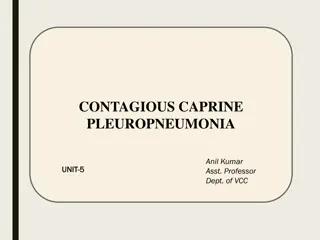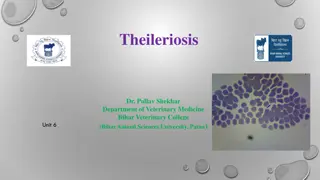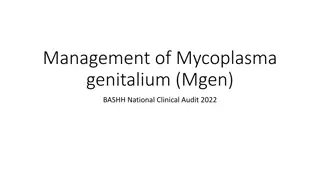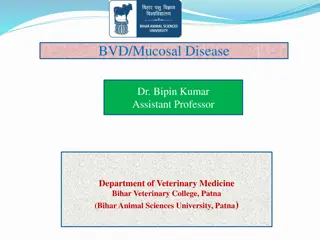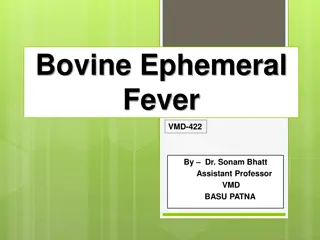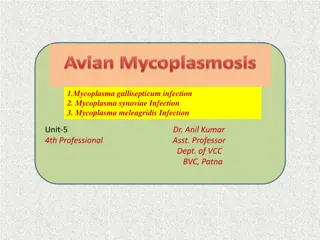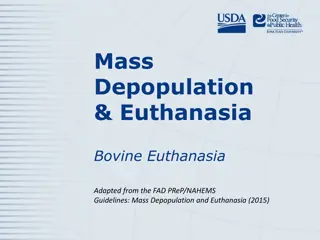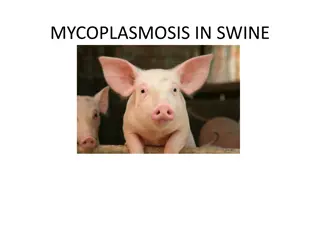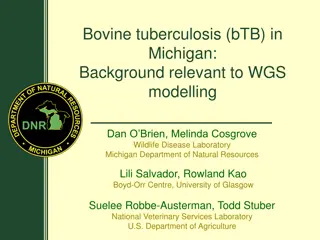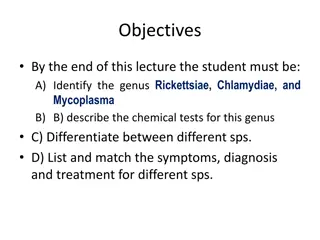Overview of Mycoplasma Species and Contagious Bovine Pleuropneumonia
The Mycoplasma genus, including Acholeplasma and Ureaplasma, consists of Gram-negative bacteria with unique characteristics such as lacking cell walls. Mycoplasma species are responsible for causing various diseases in livestock, including bovine and caprine pleuropneumonia. Contagious Bovine Pleuropneumonia (CBPP) caused by Mycoplasma mycoides subsp. mycoides is a significant concern due to economic losses in cattle production. The disease's pathogenesis involves acute lobar pneumonia and pleurisy, leading to high morbidity and mortality rates. Effective disease management strategies are crucial for mitigating its impacts on the livestock industry.
Download Presentation

Please find below an Image/Link to download the presentation.
The content on the website is provided AS IS for your information and personal use only. It may not be sold, licensed, or shared on other websites without obtaining consent from the author.If you encounter any issues during the download, it is possible that the publisher has removed the file from their server.
You are allowed to download the files provided on this website for personal or commercial use, subject to the condition that they are used lawfully. All files are the property of their respective owners.
The content on the website is provided AS IS for your information and personal use only. It may not be sold, licensed, or shared on other websites without obtaining consent from the author.
E N D
Presentation Transcript
with Mycoplasma spp. By Hussein Ali Naji
The genera Mycoplasma, Acholeplasma and Ureaplasma form the family Mycoplasmataceae , Gram-negative bacteria consisting of cells bounded by plasma membrane but stained hardly, usually use Giemsa stain, its morphology Pleomorphic, spherical, short rod, filament. Its organisms differ from other bacteria in that they are deficient in cell walls. It contains a single order, Mycoplasmatales. Mollicutes: mollis soft, cutis = skin.) And it's resistant to antibiotics that interfere with the integrity of cell wall; penicillins, cephalosporins, vancomycin, bacitracin.
Mycoplasma species caused many diseases include Bovine M. mycoides subsp. mycoides SC caused Contagious bovine pleuropneumonia, CBPP M. bovis caused Mastitis, pneumonia (calf), polyarthritis (calf)metritis, abortion, sterility M. dispar caused Pneumonia (calf) Mycoplasma (Eperythrozoon) wenyonii caused Anemia
Sheep and goat M. capricolum subsp. Capripneumonia caused Contagious caprine pleuropneumonia M. mycoides subsp. Capri caused Pneumonia, arthritis septicemia (goat) M. mycoides subsp. mycoides LC Pneumonia, mastitis, arthritis, septicemia (goat). Contagious Bovine Pleuro Pneumonia, CBPP
Contagious Bovine Pleuro Pneumonia, CBPP Etiology Mycop/asma mycoides subsp.mycoides (Small colony) (M mmSC) Methods of transmission Transmission occurs from direct andrepeated contacts between sick and healthy animals. The principal route of infection is by the inhalation of infective droplets from active or carrier cases of the disease. Spread of the disease may also occur by discharges from local tail lesions resulting from vaccination with virulent culture.
Economic importance CBPP is the most economically important disease of cattle. The direct losses are from mortality, reduced milk yield, vaccination costs, disease surveillance and research programs. The indirect costs are due to the chronic nature of the disease including: Loss of weight and working ability. Delayed marketing. Reduced fertility. Losses due to quarantine. Loss of cattle trade.
PATHOGENESIS The disease is an acute lobar pneumonia and pleurisy. The organism invades the lungs of cattle and causes a mycoplasmemia; this results in localization in numerous other sites including the kidneys and brain, resulting in high morbidity and mortality. An essential part of the pathogenesis of the disease is thrombosis in the pulmonary vessels, probably prior to the development of pneumonic lesions.
CLINICAL FINDINGS There is considerable variation in the severity of clinical disease from hyperacute to acute to chronic and subacute forms. Acute and hyperacute forms. After an incubation period of 3-6 weeks (in occasional instances up to 6 months) there is a sudden onset of high fever (40 C; 105 F), a fall in milk yield, anorexia and cessation of rumination. Coughing, at first only on exercise, and thoracic pain are evident; affected animals are disinclined to move, standing with the elbows out, the back arched and head extended. Respirations are shallow, rapid and accompanied by expiratory grunting. Pain is evidenced on percussion of the chest.
Auscultation reveals pleuritic friction sounds in the early stages of acute inflammation, and dullness, fluid sounds and moist gurgling crackles in the later stages of effusion. Dullness of areas of the lung may be detectable on percussion. In fatal cases death occurs after a variable course of from several days to 3 weeks. In the hyperacute form, affected cattle may die within 1 week after the onset of respiratory distress.
Chronic and subacute forms Recovered animals may be clinically normal but in some an inactive sequestrum forms in the lung, with a necrotic center of sufficient size to produce a toxemia causing unthriftiness, a chronic cough, and mild respiratory distress on exercise.
CLINICAL PATHOLOGY Isolation or detection of organism polymerase chain reaction (PCR) Latex agglutination test. Serological tests includes complement fixation test (CFT) and indirect enzyme-linked immunosorbent assay (ELISA).
Differential diagnosis A diagnosis based on a history of contactwith i nfected animals, clinical findings, acomplement fixation test, necropsyfindings and cultural examination isnecessary.Diseases which must be differentiatedfrom CBPP include: Rinderpest Erosive stomatitis, dysentery, and erosions throughout the alimentarytract. Foot and mouth disease Salivation, lameness, fever, and vesicular stomatitis. Hemorrhagic septicemia Acute diseasewith death in 6 to 72 hours. Edema of the neck and brisket, lung lesions similar to CB PP. Culture of Pasteurella spp.
Theileriosis (East Coast fever) Coughing, nasal and ocular discharge, diarrhea, enlargement of peripheral lymph nodes, ulceration of abomasum . No lung lesions Ephemeral fever Ocular discharge, drooling saliva, lameness, enlarged joints, self-limiting disease of short duration; most affected cattle recover quickly; fluctuating fever; secondary pneumonia may occu. Tuberculosis Tubercular nodules may resemble C BPP sequestra but they are degenerative cheese-like lesions, often calcified Actinobacillosis Generalized lesions of lung and other adjacent tissues. Echinococcal (hydatid cysts) Pulmonary cysts with a double wall and containing clear fluid, often calcified when old.




